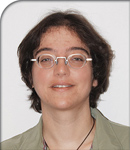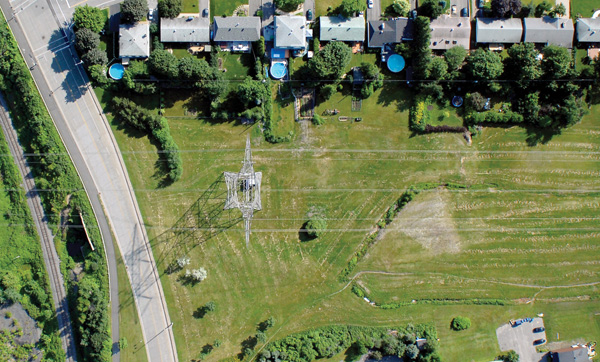Technological innovation is a powerful engine for growth and performance, and Hydro-Québec is counting on new technologies to remain on the leading edge of its industry, improve customer services and further enhance its performance. That is why Hydro-Québec will continue to integrate leading-edge technology tools into its Utility Vegetation Management (UVM) programs, an area of technology development and deployment that is becoming one of the main thrusts of it’s innovation efforts.

Martine Hamel
F.Eng., Ph.D.
Hydro-Québec Distribution

Charles Sarthou
F.Eng.
Hydro-Québec TransÉnergie
Hydro-Québec TransÉnergie (HQT) and Hydro-Québec Distribution (HQD) operate extensive transmission and distribution systems with more than 30,000 km (18,600 miles) of transmission lines and 110,000 km (68,350 miles) of distribution lines serving 3.3 million customers within the Province of Québec. In addition, Hydro-Québec has 15 interconnections with neighboring transmission systems in the US as well as in other Canadian provinces. These transmission and distribution systems need efficient Utility Vegetation Management (UVM) programs in order to reach the uppermost level of reliability. These two UVM programs can be summarized in six activities; which are: 1-Planning, 2-Inventory, 3-Prescription, 4-Tendering and Contracting, 5-Operations & Monitoring, and 6-Reporting. This article gives some examples of what actually is – or could be – HQT and HQD choices for improving the efficiency of each element (i.e., T&D) in the near future.
Planning
“Technology is already an important compo-nent of our vegetation management plans. But in the near future, we plan to integrate even more geospatial information (most derived from high-resolution aerial photogra-phy) to our program which will help improve the reliability of our six level of activities – a vital issue to Hydro Quebec.” – Charles Sarthou, Forest Engineer, Hydro-Quebec
The main philosophy of Hydro-Québec’s UVM programs is the better the information you have, the better you can plan. Electric grid information, vegetation inventories, environmental issues, topographic information, land ownership and access roads, are the kind of information that feed Hydro-Québec’s Geographic Information Systems. The analysis of this information is essential to determine the optimal vegetation cycle for each span.
To improve its planning, HQT will use a highly detailed ecological type layer provided by the Québec Ministry of Natural Resources to divide the territory. This information is then combined with new and existing field information to develop reliable local vegetation growth or vegetation density projection models into Right-of-Ways (ROWs). As field data is used to refine the different types of ecological layers, the model processes will be improved at each treatment cycle as field information is gathered, with the goal being accurate micro-models for each span.
For HQD, an interesting research avenue to improve the workload planning is to use macro level functional vegetation groups. First, the creation of these groups – around 10 for the entire province of Québec – is based mainly on digital imagery and existing dendrometric information, the latter pertaining to tree growth models. Those functional groups are then linked to climate, soil and growth competition to form a composite growth algorithm. This new layer of information can then be integrated into the GIS.
Inventory
Hydro-Québec’s transmission ROWs are spread across the Province of Québec. To be as efficient as possible, HQT’s vegetation specialists developed inventory methods that use aerial, high-resolution digital images to see the details of the vegetation without actually being in the field. These aerial images are used to quickly evaluate and map the vegetation along the HQT ROWs. Those images allow stereoscopic viewing directly on computer screens to evaluate vegetation height, density and composition and to map that information directly into a GIS.
Light Detection and Ranging (LiDAR) technology and high-density point cloud extracted from aerial photography – two promising new tools – are used for vegetation inventory on a test pilot basis to obtain the most accurate information about clearances between transmission lines and vegetation. These tools are expected to be of great help in identifying potential vegetative threats in a near future.
For distribution lines, ground patrols are performed to evaluate vegetation control needs. Each vegetation control technician is equipped with a laptop computer feeding local data storage that is synchronized with the central database on a daily basis. But even if this system works well, real-time database access may also be needed to reduce reaction times, alleviate time constraints, meet deadlines and help preserve data consistency.
Prescription
A decisional matrix is being developed by Hydro-Québec’s vegetation specialists to help with selecting vegetation control interventions in transmission Right-of-Ways.
The first step in this process is to input the physical components of an intervention area into the matrix. These components include land occupancy, vegetation height and density, distribution of physical areas, vegetation dynamics, sensitive components, and access and movement into the ROWs.
Second, the integrated vegetation management objectives are entered into the matrix. Typical objectives might include promoting compatible vegetation, protecting the environment, optimizing the growth cycle and cost effectiveness, etc. Of course, each of these objectives is carefully evaluated to reflect Hydro-Québec’s many operational priorities.
Based on these inputs, the matrix helps to produce the best treatment prescription for effectively and economically controlling vegetation. These kinds of tools also provide technical assistance in determining and applying the proper treatment at the right location at the best time. Moreover, the development of this kind of matrix facilitates an efficient and effective dialogue between the planning team and field personnel.
Tendering and Contracting
Formal tendering documents are created from prescription information. The Internet is used extensively by Hydro-Québec to optimize the tendering process by reducing document transmission times and maximizing the information needing to be broadcast to potential contractors and other suppliers.

In the near future, Hydro-Québec may also use the Internet for online reverse auctions for certain bid opportunities. Hydro-Québec is also exploring the possibility of giving access to bidders for GIS data and aerial images via an online GIS tool. With better information, Hydro-Québec can give its contractors tools that can help them to better evaluate vegetation control jobs, and minimize unforeseen risks. By doing so, contractors can develop more accurate pricing that more closely relates to actual field conditions and requirements.
Majors changes are also in sight regarding the management practices of silviculture companies. A new certification program has been developed by the Bureau de normalisation du Québec (BNQ) with the objective of eliminating unfair labor practices. The implementation of this certification program and the inclusion of a registration management system will be in force by September 2010 and mandatory for all silviculture work performed in the Province’s public forest domain. HQ intends to also implement this policy within its UVM programs in the near future. In a context of labor scarcity, HQ believes in the importance of avoiding unhealthy competition like moonlighting, subcontracting chains and health & safety noncompliance. Technology can help us cope with these new management trends.
Operations & Monitoring
As Kevin Eckert, Arbor Global’s founder, President and Managing Director, once said, “You get what you inspect; not what you expect!” Indeed, the main purpose of monitoring is to support day-to-day operations, but there are also additional reasons for monitoring. For example, monitoring should ease the tracking of productivity and facilitate environmental awareness as well as help to improve public relations by doing a better job, both at the planning and at the execution stages. It is also the starting point to make the basic data available for the service evaluation process, which is why, in Hydro-Québec’s opinion, this part of any UVM program greatly benefits from available technology solutions. For example, HQT technical personnel will use tablet-PCs to bring the office to the field, providing access to data, work orders and other information they require to maintain a complete and comprehensive monitoring posture.
“You get what you inspect; not what you expect!”
- Kevin Eckert, Arbor Global President & Managing Director
This field monitoring application has five main modules…
The first of these is called Command and generates the tree structure where each folder contains the data related to each contract. This module also allow us to enter the work progress schedule of each contract.
The second module is called Areas Monitoring. As the name suggests, the goal is to document the completed areas as well as the method in which they were performed using the GIS data generated in the Inventory process. If non-compliant, to project specifications, the area is rejected and policy dictates that the work be retaken.
The third module is called Production Follow-up. Although, it should be mostly useful for Time and Material (T&M) contracts, this module allows a precise monitoring of the productive and unproductive activities, very useful to rectify potential problems.
The fourth module is called Expertise & Know-how. This new module will be tested this summer. Its goal is to documented the “soft” parts of contracts like report consistency, workers performance, respect of the living environment, compliance with health & safety plans, business relations, customer orientation, etc. In fact, we believe that “soft” can be scientific if you obtain quantifiable data, rely on a systematic method and focus on objectivity.
The last module, called Qualification Process Monitoring, will integrate data from Areas Monitoring and from Expertise and Know-how to give facts oriented rating of global (“hard” and “soft”) contractor’s performance. The main challenge of this module will be to find the right rate for each test point.
Reporting
The reporting component captures and documents the facts needed to insure that what has to be done is actually being worked on and completed. But it takes more than just of rows and columns of data, tables and graphs to represent key indicators like cost and surface area. In fact, surface area by itself is the kind of indicator that is no longer sufficient for HQT. Complying with clearing rules – specifically NERC Standard FAC-003-1 – necessitates an increased frequency for measuring and monitoring vegetation reliability threats. Thus, a close link must be made with all the previous parts, including data warehouses that are designed to facilitate reporting and analysis.
It is also important to close the entire UVM program cycle. One way to do that is by integrating many tools into a single software package – a promising new trend that is quickly gaining momentum. By combining powerful databases with GPS technology, LiDAR data and high-resolution orthographic photos, a much more encompassing UVM program can be undertaken and more complete results can be obtained as a result.
Finally, the reporting system – or data warehouse – should measure overall work efficiency. This is closely linked to the related cost per unit (e.g., ha, km, span), but it should also reflect compliance with the updated workload as progress is made and the cycle is completed. This type of continuous monitoring is also a first step toward appropriately adjusting UVM funding and spending, rather than basing such budgeting and expenditures solely on historical practices and amounts.
Conclusion
Utility vegetation management is a vital reliability issue. The immediate impact of the Northeast Blackout of 2003 was not only the loss of 80% of the energy load in New York, but also the birth of the fear that it may append again and again. The investigation joint task force, formed by the governments of Canada and of the United States, concluded that the main cause of the blackout was a failure to trim trees. We, the system foresters, understood the lesson. Since then, a considerable amount of field work is being carried out each year and a great deal of “brain power” is currently at work on the issue.
We think that finding new ways to save time, money and be more effective using innovative technologies for vegetation management programs are all important ingredients in continuous improvement of UVM programs from both a budgeting and an execution perspective. The integration of environmental and social concerns is also a fundamental prerequisite that can be more easily accommodated with a little help from technology. Hydro-Québec is counting on its strategic and technical personnel to carefully choose (and skilfully) use innovative technologies to improve its performance in the UVM area. All six parts of UVM programs can be supported by these tools.
About the Authors
Martine Hamel is a Forest engineer with a PhD in forest sciences. She works as a provincial Advisor – Vegetation for Hydro-Québec Distribution at the Asset Management Direction. Her responsibilities include strategic orientations of the HQD vegetation management team, functional oversight for UVM R&D and coordination of the Project Management office.
Charles Sarthou is a Forest engineer. He works as provincial Technical Support for Hydro-Québec TransÉnergie in the Asset Planning and Transmission Expertise Department. His responsibilities include guidelines for the HQT vegetation management program, functional oversight for UVM R&D and participation in the quality assurance program regarding the activities of operational units.







